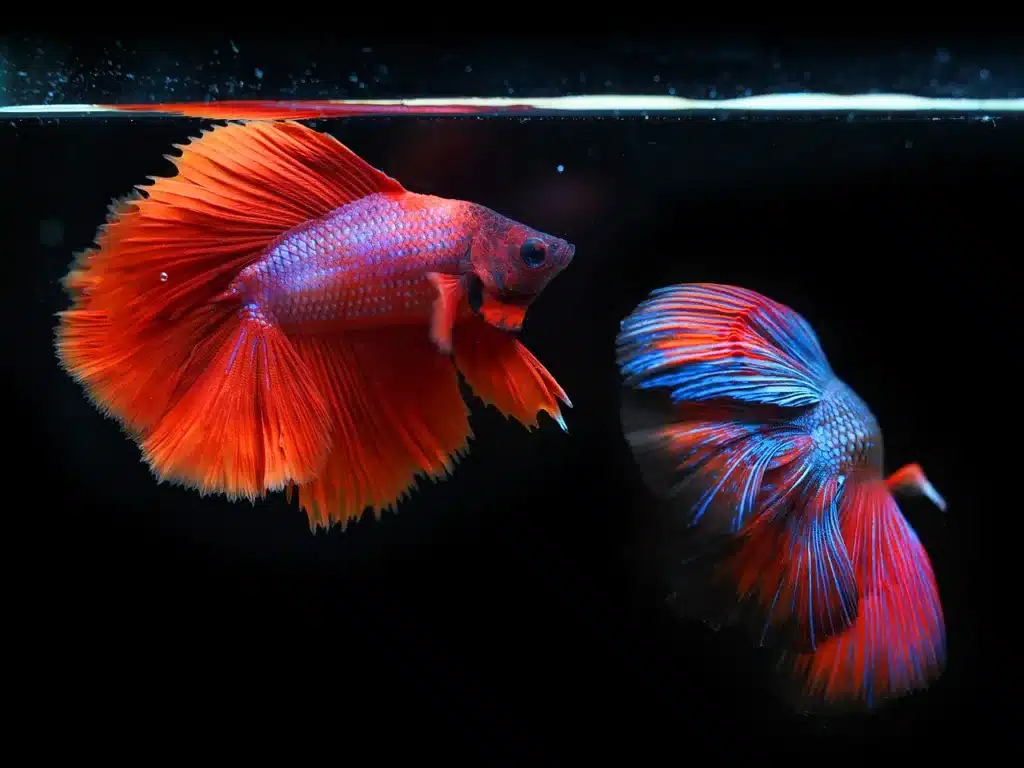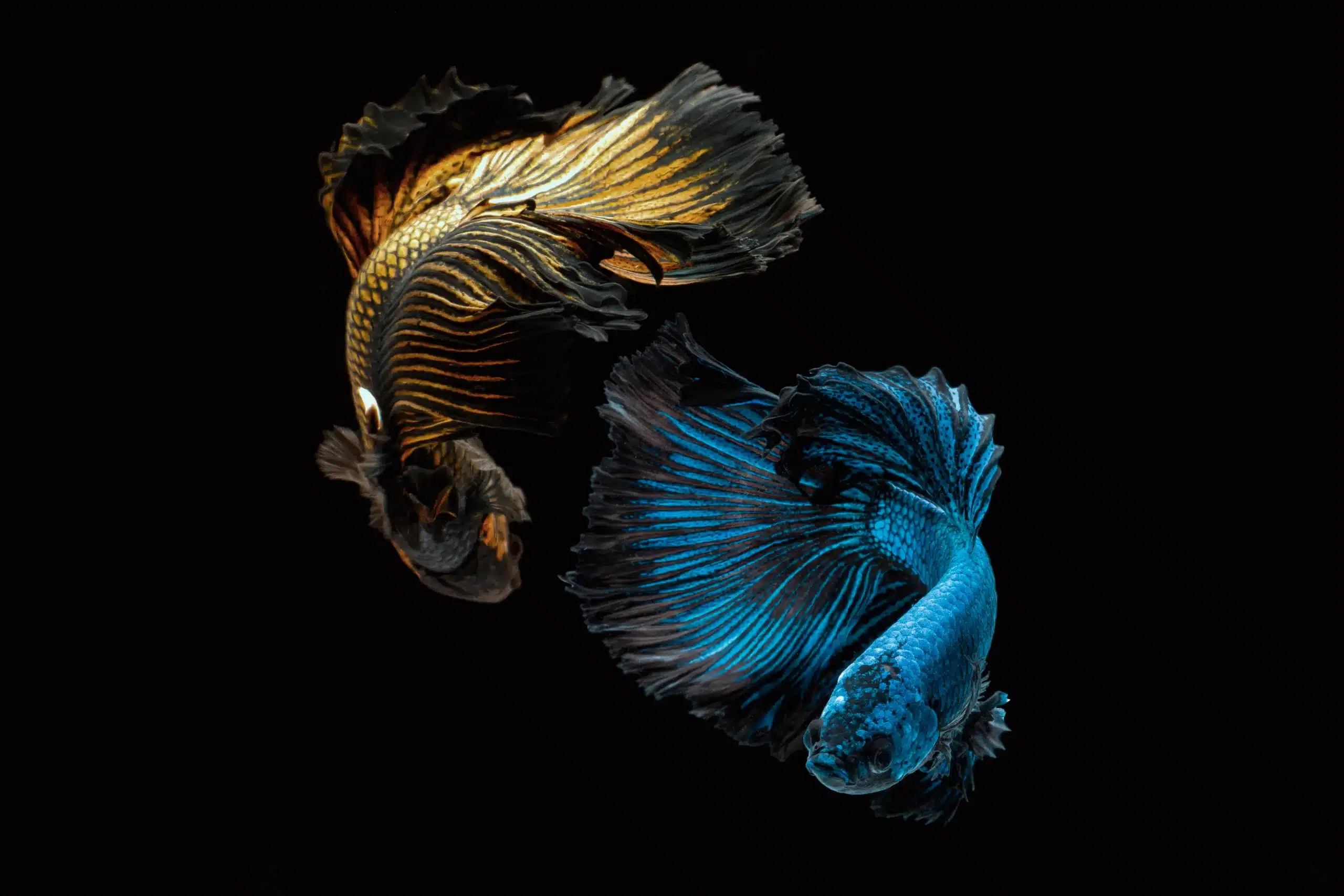Hey there, fellow Betta enthusiasts! Have you ever gazed into your aquarium and wondered what’s going through the minds of those vibrant little swimmers? Mainly those flashy female Betta fish — known for their less aggressive reputation than their male counterparts, but still seemingly nippy at times. It’s a topic that’s sparked many a debate among us fishkeepers:
Do female Betta fish fight, or is it a harmless fin-flapping?
Well, I’ve been right there with you, perched in front of my tank, trying to decode the flares and chases. And let me tell you, it’s been quite the journey of discovery. Female Bettas, while they don’t have the same boxing-ring reputation as the males, definitely have their own behavioral telenovelas beneath the water’s surface.
In this little guide of ours, we’ll dive into the whirlpool of female Betta behavior — unraveling myths, interpreting those fin slaps, and figuring out just what makes these ladies tick. And trust me, it’s not just about figuring out who’s the alpha or whether they’ve got a bone to pick with their tank mates. It’s about understanding their world. Knowing is the first step to creating a serene underwater community where finned friends can live harmoniously.
So, buckle up your seatbelts (or should I say, fasten your aquarium lids?) because we’re about to get into the nitty-gritty of what causes those female Bettas to sometimes lash out and how we, as their caretakers, can play peacekeeper. Whether you’re a seasoned Betta keeper or just starting out with your first bubble-nesting beauty, there’s something here for you. Let’s figure out how to stop our female Betta fish from fighting and turning their battleground into a playground. Ready? Let’s go!
Do Female Betta Fish Fight?
Alright, let’s tackle the burning question head-on: Do female Betta fish fight? You might have heard that only the boys are prone to throwdowns, earning them the name “Siamese fighting fish.” But here’s the scoop — the ladies can have a bit of a tiff, too. It’s not quite the same showdown you’d expect from the males, but female Bettas, bless their fins, can stir up some drama.
When you peek into the tank, sometimes there’s a bit of a stare-down between the gals. And you might notice a chase here or there. But are these ladies just throwing shade, or are they duking it out?
Well, from my time hovering over tanks and chatting with fellow Betta enthusiasts, I’ve learned that female Bettas definitely have their moments. They can be territorial, they can be moody, and yes, they can be aggressive. It’s not always as intense or lethal as with males, but it happens.
They’ll flare their gills, spread their fins, and even go for a nip at a tank mate. Sometimes, it’s over before you know it, a quick spat to say, “Back off, this leaf’s mine!” Other times, it can be a bit more serious, especially if you’ve got a feisty girl who’s decided she’s the queen of the tank.
The key is knowing when to step back and let them sort out their pecking order and when to step in because the sorority is turning into a bit of a battleground. But don’t worry, it’s not all doom and gloom in the Betta world. With savvy management and a good understanding of their needs, we can keep the peace and avoid these scuffles.
So, are we destined to have a female Betta version of ‘Fight Club’ in our tanks? Not necessarily. Stay tuned because we’re about to dive into the do’s and don’ts, the whys and hows of keeping our female Betta fish from turning those flirty fins into weapons of mini destruction.

Factors Contributing to Aggression Among Female Bettas
Oh, the drama of the Betta tank! If you’ve ever caught your female Betta fish glaring at each other like divas at an award show, you know what I’m talking about. So, what’s actually flipping their aggression switch? Let’s swim through some of the factors that can turn your tranquil tank into a bit of an underwater “Real Housewives” episode.
First up, space – or the lack of it. Imagine being stuck in an elevator with strangers; tempers are bound to flare, right? Female Bettas need their room just like we do. A cramped tank can lead to some severe fin-slapping because everyone’s on top of each other, and nobody’s got space to chill.
Then there’s the decor—or should I say, the stage for the drama. Just like we need our corners to retreat to, these ladies appreciate some privacy. Without enough plants, caves, or hidey holes, there’s nowhere to escape the spotlight, and it can make them more prone to lash out.
Remember the pecking order. Yes, even female Bettas have a social ladder, and they’re not above a tussle to climb it. When a new girl enters the tank, the existing ones might puff up and show who’s boss. It’s like seeing a new employee try to use the boss’s coffee mug on day one. Boundaries, ladies!
And hey, let’s talk about the dinner table. Feeding time can be like Black Friday at the mall if there’s not enough to go around or it’s all dropped in one spot. A little competition is natural, but too much can mean trouble.
Now, remember the mirror effect. If your tank is too bare and reflective, a female Betta might mistake her own reflection for another fish and start a fight with, well, herself. It’s like arguing with yourself in the mirror because you can’t decide on an outfit – except with more fin-nipping.
Lastly, it’s worth mentioning that sometimes the issues are hormonal or health-related. Like us, if a Betta’s not feeling top-notch, they might get snappy.
So, what’s the takeaway from all this? Keep your Bettas’ home spacious, interesting, and comfortable, give them a balanced diet, and make sure they’ve got room to establish a pecking order without turning your tank into a fin-flapping fiasco. It’s all about setting the stage for harmony and keeping those female Betta tiffs to a minimum.
How To Stop Female Betta From Fighting
Alright, so you’ve got the lay of the land — or should I say, the layout of the tank — when it comes to our female Betta fish sometimes acting like there’s a bad sale at the fish store and everyone wants in. But how do we turn down the heat when things get too spicy? Let’s get into the nitty-gritty of maintaining peace in the tank.
First off, let’s talk about the setup. Think of it like a college dorm. You wouldn’t just throw everyone into one room and say, ‘Get along.’ Nope, you’d give them their space, some common areas, and enough resources so nobody has to squabble over the last packet of ramen. So, for your Bettas:
- Give them space: We’re talking at least a 10-gallon tank for a sorority of female Bettas. They need room to swim and claim their own little corners of the world.
- Rearrange the furniture: Add plenty of plants and decorations. These aren’t just for looks; they’re crucial for breaking up lines of sight so the girls can have privacy. They can’t fight if they can’t see each other, right?
- Dining etiquette: Scatter feed or use multiple feeding stations to prevent those mealtime melees. Think tapas-style — a little bit here, a little bit there, and everyone gets something without stepping on fins.
- Mix up the sorority: When introducing new females, do it in groups rather than one at a time. It’s less likely for multiple fish to get singled out and bullied. It’s like showing up to the first day of school with your squad — much less intimidating.
- Monitor and adjust: Keep an eye on the tank dynamics. You may need to play referee and separate a particularly bossy Betta until she chills out.
- Floating plants or refuges: These can be lifesavers, literally. They provide a break from the constant visibility and a place to retreat after a little spat or during stressful moments.
Now, here’s a pro tip: If things get a little too West Side Story and you’ve got a rumble in the tank, try rearranging the tank décor. This throws everyone off their game and can reset territories. It’s like shaking up the Etch A Sketch — everyone starts fresh.
Remember, it’s all about creating a Betta world that’s less ‘Hunger Games’ and more ‘peaceful coexistence.’ It’s not always easy, and it might take some trial and error, but hey, that’s part of the fun (and challenge) of keeping these beautiful fish.
So gear up with your plants, patience, and problem-solving hat, and let’s work on making your Betta tank the zen garden it’s meant to be. Keep an eye out for the next section, where we’ll dive into the Betta tank maintenance routine that’ll keep those little ladies as happy as clams. Or as serene as Bettas in a well-managed tank?

Monitoring and Maintaining a Peaceful Betta Tank
Alright, you’ve set the stage for peace in the bustling underwater city that is your Betta tank. But keeping the zen in those waters isn’t a ‘set and forget’ deal. You must keep a watchful eye and be consistent with your care. Here’s how you keep the calm going long-term.
Consistent Monitoring: Daily Check-ins
Pop by your tank daily and observe. It’s like people-watching at the park, except you’re fish-watching. Look for signs of stress or aggression: Is anyone hiding all the time, or is someone always being chased? Any nipped fins or other injuries? Keeping a close eye helps you catch the drama early before it becomes a full-blown soap opera.
Behavior Tracking: Know Your Fish
Get to know your Bettas’ personalities. Like snowflakes, each one is unique. Some are chill, others are party animals, and a few might always seem like they got up on the wrong side of the gravel. If you know what’s normal for them, you’ll quickly notice when something’s off.
Feeding Rituals: Avoiding the Food Fight
Feeding time is often when the claws (or, well, fins) come out. Establish a ritual — same time, same place, and maybe even mix in some sneaky distraction techniques. Drop food in different tank sections, use feeding rings, or spread the feast. Keep the peace by keeping the bellies full without the brawl.
Tank Maintenance: Clean and Serene
Keep that water cleaner than a five-star hotel room. Regular water changes, filter maintenance, and keeping tabs on water parameters — pH, ammonia, nitrates, and the like — will prevent a lot of stress-induced squabbles. A clean tank is like a clean house; everyone gets along better.
Resort-Style Refuges: Plant It Up
Natural or silk plants, caves, and even floating Betta logs — these are the resorts and hideaways for your finned friends. They provide rest areas and reduce the temptation for a fish to claim the entire tank as her personal empire.
Time-Outs: The Isolation Play
Got a bully in the ranks? A time-out might be in order. A separate breeding box within the tank can give the aggressor time to cool off without completely isolating her from the community.
Stress Reduction: The Spa Treatment
Consider Betta hammocks, gentle filtration, and subdued lighting to keep the stress levels down. Think of your tank as a spa; if the environment is soothing, the inhabitants will be too.
TLC: The Secret Sauce
Lastly, give your Bettas some love. Talk to them, watch them, interact with them. When you’re engaged, you’re more attuned to their needs, and they feel the good vibes. Plus, it’s pretty therapeutic for you, too.
Remember, even with all this, some squabbling is natural. You can’t eliminate every chase, every flared gill, but you can create a tank environment that reduces the reasons for these behaviors. It’s all about being proactive rather than reactive and about creating a tank community that’s got more peace treaties than territorial disputes. Keep up these practices, and you’ll be more than just a Betta owner — you’ll be a Betta peacekeeper!
Conclusion
Alrighty, let’s wrap this up! We’ve swum through the ins and outs of Betta personalities, the do’s and don’ts of setting up a harmonious tank, and the daily rituals to keep those female Bettas from turning your aquarium into a fin-flapping fracas. It’s been quite the underwater journey!
To sum it all up, yes, female Betta fish can have their moments of finned fury, just like their male counterparts, although often less intense. But with the proper tank setup, a keen eye for their behavior, and a bit of patience and understanding, you can keep the peace and enjoy the vibrant dance of these beautiful creatures in a serene aquatic world.
Remember, it’s all about providing ample space, plenty of hiding spots, and regular tank maintenance to ensure your Betta buddies live their best lives. Keep those meals civil with strategic feeding strategies, and don’t shy away from giving time-outs if things get too heated. And through it all, keep a close watch on their interactions — prevention is, as they say, better than cure.
Taking care of Bettas, particularly a sorority of females, is as much an art as a science. It’s about blending your understanding of their needs with a dash of creativity in tank management. When done right, it’s incredibly rewarding. You’ll not only have a beautiful tank to gaze at but also the peace of mind that comes from creating a healthy and stress-free environment for your aquatic pets.
So, here’s to all the Betta keepers out there — may your tanks be peaceful, your fish be healthy, and your Betta-keeping adventures be as colorful and lively as the fish we all love.
Dive into this fin-tastic hobby with all the care and enthusiasm you can muster, and enjoy every moment of the splashy splendor that female Betta fish bring to your home. Happy Betta watching!
FAQ Section: Betta Fish Care and Behavior
Q: Can female Betta fish live together peacefully?
A: Yes, they can, but it requires a larger tank, careful planning, and consistent monitoring. A group of female Bettas living together is known as a sorority. While they can cohabitate, they do establish a hierarchy, which can sometimes lead to skirmishes.
Q: What are the signs of aggression in female Bettas?
A: Signs of aggression include flaring gills, chasing other fish relentlessly, nipping fins, and overall hostile behavior like trying to dominate food during feeding time.
Q: How do I introduce new female Bettas to a sorority?
A: When introducing new females to an established tank, it’s best to rearrange the tank décor to disrupt the established territories and then add the new fish. This helps to prevent the existing fish from immediately becoming aggressive toward the newcomers.
Q: What should I do if one female Betta is being bullied?
A: If a female Betta is being bullied, try rearranging the tank to break up territories. If this doesn’t help, you may need to isolate the aggressor or the bullied fish temporarily. In some cases, permanent separation might be necessary for the bullied fish’s well-being.
